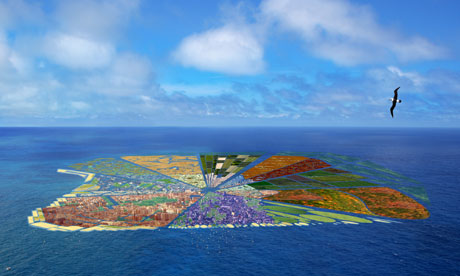The proposal has three main aims; Cleaning our oceans from a gigantic amount of plastic waste; Creating new land; And constructing a sustainable habitat. Recycled island seeks the possibilities to recycle the plastic waste on the spot and to recycle it into a floating entity. The constructive and marine technical aspects take part in the project of creating a sea worthy island.
The main characteristics of the island are summarized:
1. Realized from the plastic waste in our Oceans. This will clean our Oceans intensely and it will change the character of the plastic waste from garbage to building material. The gathering of the plastic waste will become a lot more attractive.
2. The island is habitable, where it will have its value as land capturing and is a potential habitat for a part of the rising amount of climate refugees.
3. The habitable area is designed as an urban setting. Nowadays already half of the World population lives in urban conditions, which has a huge impact on nature. The realization of mixed-use environments is our hope for the future.
4. The island is constructed as a green living environment, from the point of view of a natural habitat. The use of compost toilets in creating fertile ground is an example in this.
5. It is a self sufficient habitat, which is not (or hardly) depending from other countries and finds its own resources to survive. The settlement has its own energy and food sources.
6. The island is ecologic and not polluting or affecting the world negatively. Natural and non polluting sources are used to let the island exist in harmony with nature.
7. The size of the floating city is considerable in relation to the huge amount of plastic waste in the Ocean. The largest concentration of plastic has a footprint the size of France and Spain together. Starting point is to create an island with the coverage of 10.000Km2. This is about the size of the island Hawaii.
8. The location is the North Pacific Gyre, where at this moment the biggest concentration of plastic waste is discovered. This is geographically a beautiful spot North-East to Hawaii. By recycling and constructing directly on the spot with the biggest concentration of plastic waste, long transports are avoided. Because of the floating character the position could eventually be altered.
http://www.recycledisland.com/index.html

A floating city of half a million people on a vast plastic island. Does that sound like Waterworld? The vision could soon be a reality if Dutch conservationists have their way. Recycled Island is a plan to clean up 44 million kilos of plastic waste from the North Pacific Gyre, which stretches from California to Japan, and provide 10,000 square kilometres (3,861 square miles) of sustainable living space in the process. Solar and wave energy would provide power for islanders while sustainable fishing and agriculture could provide their food.
According to the website for Whim Architecture, which designed the concept: "The proposal has three main aims: cleaning our oceans from a gigantic amount of plastic waste, creating new land and constructing a sustainable habitat."
There is an estimated 100m tonnes of plastic flotsam in the Pacific Gyre, where ocean currents cause it to accumulate. The floating dump covers an area one and a half times the size of the US.
Captain Charles Moore of the Algalita Marine Research Foundation (AMRF) was the first to find the huge, floating plastic dump in 1997. On the foundation's website, he described it as "just absolutely gross – a truly disgusting plastic cesspool. [It] has to be burned into the consciousness of humanity that the ocean is now a plastic wasteland".
Because petroleum-based plastics are non-biodegradable, any plastic that enters the ocean stays there, continually breaking into smaller pieces until it is ingested by marine life or deposited on the shore. In a 1998 survey, 89% of the litter observed floating on the ocean surface in the North Pacific was plastic. In the Central Pacific Gyre, the AMRF in 2002 found six kilos of plastic for every kilo of plankton near the surface. By 2008, that figure had risen to 45 to one.
Birds like albatrosses eat the larger pieces which block their stomachs, while smaller pellets can cause fatal intestinal damage in fish.
Recycled Island could be a unique opportunity to save marine life. "The project should be carried out with great care so no negative influence to the environment is made," states the project's website. "Our ideal is to return more balance to the environment and set an example of how an environment-friendly habitat could be created."
تعليقات
إرسال تعليق